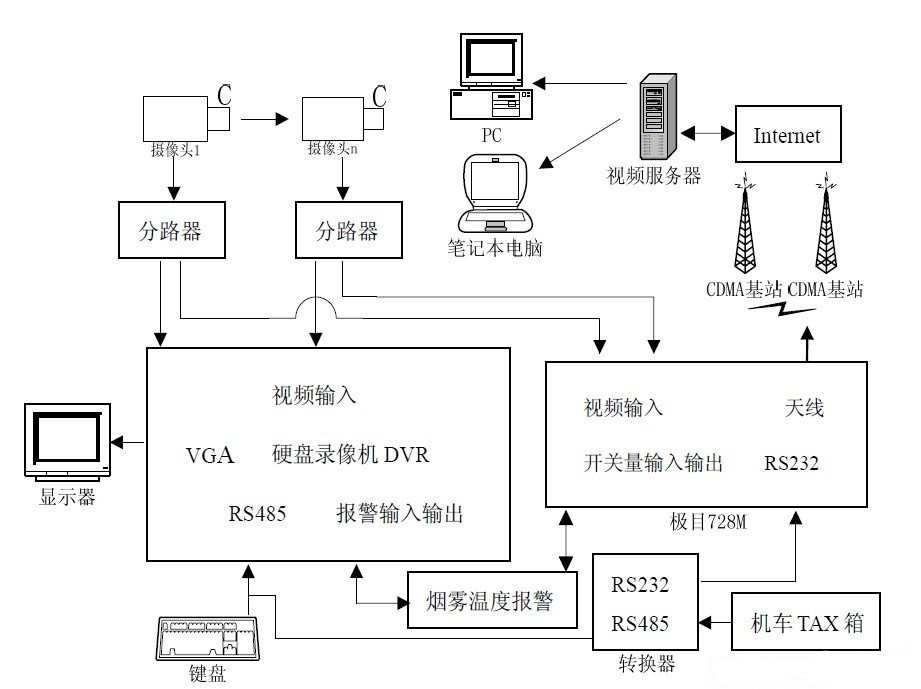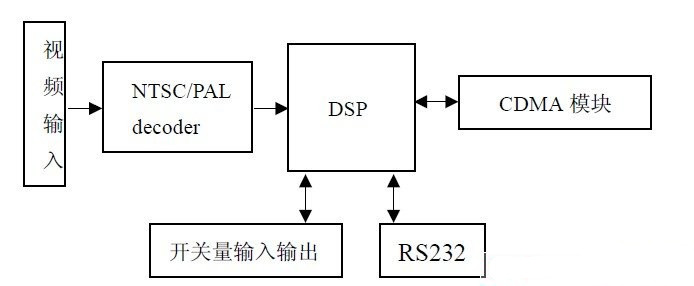Abstract: This paper analyzes the necessity of configuring video surveillance system on locomotive, compares the advantages and disadvantages of GPRS, CDMA and WLAN, and concludes that CDMA is most suitable for developing this system. This paper discusses the system implementation scheme based on DVR and wireless video transmission module, and describes the software and hardware structure of vehicle, video server and remote monitoring.
This article refers to the address: http://
1 Introduction
With the continuous development of China's railway industry, the speed of locomotives is getting faster and faster, ensuring the smooth and safe driving of locomotives has become the top priority of the railway transportation department. Helping drivers and ground management departments to monitor the locomotive operation status in real time has become a top priority. . Especially after the locomotive driving is reformed by the positive and the deputy driver to a single driver value, a driver must monitor the operation between the power room, the auxiliary room, and the electrical room while operating the locomotive. Under such a background, it is very important to develop a locomotive video surveillance system to help drivers monitor the entire locomotive in the cab and assist the ground management department to remotely grasp the locomotive operation status in real time. This paper discusses the basic development plan of locomotive video surveillance system from the aspects of network selection and system structure.
2. Wireless network selection
In order for the ground management department to monitor the locomotive operation in real time, the system must use a wireless network to transmit data. At present, there are three types of wireless networks that can be used for large-data-capacity video signal transmission in China, namely, China GPRS, China Unicom's CDMA2000 1X, and China Netcom and China Telecom's WLAN. These three wireless networks each have their own advantages.
The following compares the advantages and disadvantages of these three wireless networks in terms of speed, stability, coverage, and tariffs, and selects a wireless network suitable for the locomotive video surveillance system.
(1) speed
The theoretical transmission rate of GPRS network can reach 171.2kbps, the carrier claims that the transmission rate can reach 115kbps, the actual transmission rate is about 40kbps; the theoretical transmission rate of CDMA2000 1X network can reach 153.6kbps, the actual transmission rate is about 70kbps; the theoretical transmission rate of WLAN network can reach 11Mbps, the actual transmission rate can reach 8Mbps, but the number of accesses is affected by the number of accesses. The smaller the bandwidth allocated by each user, the slower the transmission rate.
From the speed of the network, the CDMA2000 1X network is much faster than the GPRS network, and the WLAN network is faster, but it is affected by the number of users.
(2) Stability and coverage
The GPRS network can be used as long as there is a network signal. Currently, the network coverage of GPRS is very perfect and the signal is very stable. Like the GPRS network, the CDMA2000 1X network can be used as long as there is a network signal. The network coverage and signal stability of the CDMA2000 1X is not as good as the GPRS network, but it is also acceptable. The coverage of a WLAN network is still very limited and can only be used in the vicinity of a wireless AP, which has certain limitations in its use.
In terms of network stability, the coverage and stability of GPRS and CDMA networks are good, and the coverage of WLAN networks is insufficient and usage is limited.
(3) Tariff
At present, operators of all three networks have launched a number of packages, including annual, monthly, and packet traffic. Comprehensive comparison of the various tariff standards of these three networks, CDMA2000 1X network tariffs have the most advantage.
Through the comparison of the above three aspects, the advantages and disadvantages of the three networks are clarified. Combined with the needs of the locomotive video surveillance system for wireless networks, it was decided to use China Unicom's CDMA2000 1X network.
China is preparing to vigorously develop 3G networks for TD-SCDMA, and CDMA2000 1X is a transitional phase to 3G networks. The CDMA2000 1X network is used to develop the locomotive video surveillance system. After implementing the 3G network standard in China, it is convenient for developers to upgrade the products so that the locomotive video surveillance system can enjoy better network services.
3. System structure
The whole system is divided into three parts, namely the vehicle end, the video server end and the remote monitoring end. These three parts rely on the CDMA2000 1X network and Internet connection. The system structure diagram is shown in Figure 1.

Figure 1 system structure diagram
3.1 Car terminal
The car end is an important part of the locomotive video surveillance system, which will be in direct contact with the locomotive driver. In order to facilitate development and shorten the development cycle, it is proposed to use a hard disk recorder and a wireless video transmission module as the core to form a vehicle-end system.
The DVR series selected the ADR series embedded digital hard disk recorder from Shenzhen Jingyang Company. It uses industrial-grade digital signal processor and embedded operating system (Vxworks), which is reliable and stable. It supports 16 channels of video input, and the driver can select 1 or more channels through the RS485 interface in the cab. At the same time, it also supports multi-channel alarm input, can install temperature and smoke sensor in key parts of the locomotive, and access the corresponding interface of the hard disk recorder. When the temperature and smoke of the locomotive are abnormal, the DVR can issue an alarm to remind the driver.
The wireless video transmission module selects the 728M-CDMA wireless video transmitter of Beijing Baimu Company, which can be redeveloped by the SDK provided by the manufacturer, which is very convenient. The functional structure of the module is shown in Figure 2.

Figure 2 728M structure diagram
The 728M adopts an active video compression algorithm based on H.264, which has the characteristics of high compression efficiency and low system power consumption. Due to the special processing in chroma compression, it achieves high compression efficiency while ensuring good resolution and color reproduction quality. The highest resolution is up to 704x576. The module has built-in CDMA communication control protocol and TCP/IP protocol. Support dynamic or fixed IP address mode, support domain name resolution, multiple trigger startup modes, 2 2-way auxiliary serial port, connect serial user equipment, support bidirectional measurement and control data multiplexing. The transmission rate is: color 320x240/CDMA2000 1X - average 5 frames / sec, up to 15 frames / sec; color 640x480 / CDMA2000 1X - average 0.5 frames / sec, up to 2 frames / sec.
The NTSC or PAL video signal output from the camera is connected to the module, decoded by the decoder and sent to the DSP chip.
The DSP adopts the H.264-based video compression algorithm, which adopts multiple latest video compression technologies such as multi-mode multi-size motion estimation and 4x4 integer lossless transform, and has the advantages of high coding efficiency and good image quality. The DSP sends the compressed video data to the CDMA module, and sends the video data to the video server through the wireless network, thereby realizing the wireless transmission of the video signal.
In addition, the operation record unit on the locomotive is an important device to ensure the safe operation of the locomotive. It records the data of the locomotive during operation. On the vehicle side, these operational data can be read out from the locomotive TAX box in real time through a small single-chip microcomputer system, and sent to the RS232 interface of the 728M module, and the data can be wirelessly transmitted to the server, so that the ground monitoring personnel can also real-time. Learn about the data on locomotive operation.
3.2 Video Server
The video server is a key part of the entire locomotive video surveillance system. It is the hub for the vehicle-side and ground-based remote monitoring terminals. The vehicle side sends the data to the server through the wireless network, and the remote monitoring terminal browses the important data in real time through the video server. Because of the large amount of video data that needs to be processed, the video server needs a hardware platform that performs well and runs stably. In addition, you need to apply for a separate fixed IP address, so that each ground remote monitoring terminal can access the video server. The video server software is developed on the SDK provided by Baimu Company and is compatible with the 728M. It is simple and convenient. The server software workflow is as follows:
(1) The server starts, sending a short message containing local address information to the vehicle end, and the vehicle end is in an offline state; (2) after receiving the short message, the vehicle end automatically goes online and then connects with the server, and the vehicle end is at the time The sleep state; (3) the server sends an activation command to the vehicle end. When the vehicle side is activated, the server can control the transmitter to transmit the video image, and can perform other remote operations, and the vehicle end is in an active state; (4) the server After the operation is complete, disconnect the transmitter and then shut down the server, and the site is offline.
3.3 Remote monitoring terminal
The remote monitoring terminal is a platform for ground management personnel to monitor the running status of the locomotive and the driving situation of the driver in real time. It is only necessary to install a set of client software on a common PC that can access the Internet. The video server first assigns a user name and password to each ground monitoring terminal. The remote monitoring terminal logs in to the video server through the client software using the user name and password. Different levels of users can obtain different permissions and browse or control each vehicle terminal. The remote monitoring client software workflow is as follows:
(1) Set network parameters, including server address/port, local address/port, username/password; (2) connect to the video server to determine whether the connection is successful or failed, and generate corresponding events; (3) after connecting to the video server, Car-side list, select the name of the car-end to be browsed, and start video browsing; (4) After starting the video browsing, you can set the video parameters and select different screen browsing on the car; (5) After ending the video browsing, you can The video server waits for and disconnects.
4 Conclusion
It is necessary to develop a locomotive video surveillance system, which can help drivers to better drive locomotives, reduce the driver's work pressure, reduce the driver's work intensity, and improve the safety of locomotive driving. In addition, the system can help the ground management department to implement remote real-time monitoring for easy management.
The development solution is built on the DVR and video transmission module, with a short development cycle and simple and feasible process.
We design, engineer and fabricate mold tooling, both standard and custom. We continuously design custom tooling to satisfy our customer needs. These tools are built for machines such as Newbury, Autojector, Ameriplas, Multiplas, etc. Our Solidworks 3D design capabilities represent the leading edge in the industry.
We provide training and know-how to our customers. We offer this unique advantage to companies interested in On-site training to assist in the development of in-house capabilities. Our company can become your "over -mold engineering department" and can provide quick turn-around, high quality for customers' the complete cable set with Wire Harness, plastic, silizone o-ring, metal terminal, or plate, etc. Try to give you the whole supporting service.
Molded Plastic Products,Plastic Box For Cables,Waterproofing Plastic Box,Plastic Connectors,Plastic Cap,Plastic Bushing
ETOP WIREHARNESS LIMITED , https://www.etopwireharness.com